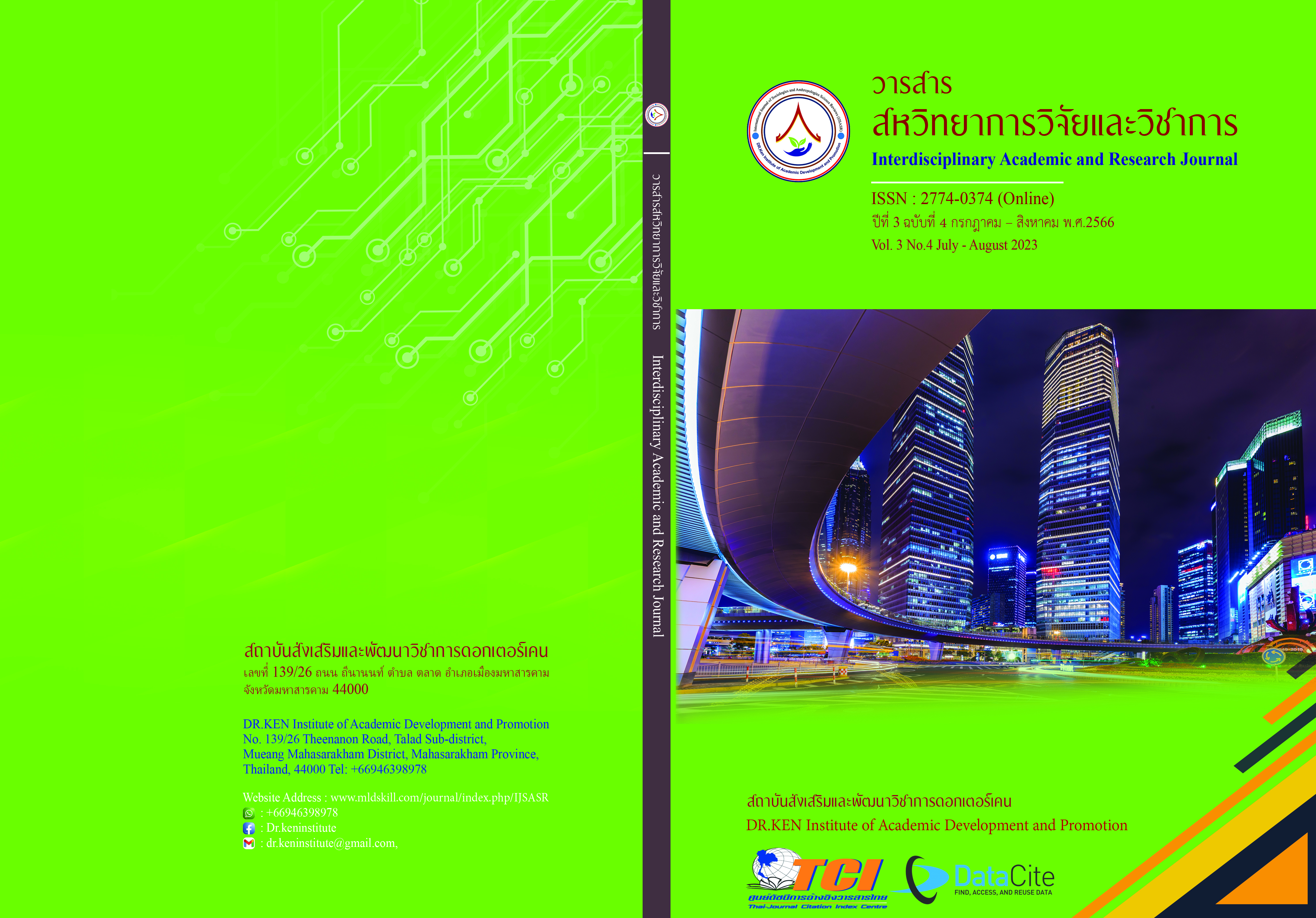Learning Achievement Handball Basic Skills by Student Teams Achievement Divisions (STAD) of Mathayomsuka 3 Students at Strisuksa School
DOI:
https://doi.org/10.14456/iarj.2023.225Keywords:
Basic Skills for Handball; , Collaborative (STAD)Abstract
The Basic Education Core Curriculum for the year 2008 (B.E. 2551) in Thailand has outlined the content of the subject "Physical Education." It states that students should learn about various forms of movement, participate in physical activities and sports, both individual and team-based, from both Thai and international perspectives. They should also learn to adhere to rules, regulations, and agreements when participating in physical activities and sports, as well as develop sportsmanship. The objectives of this research are as follows: 1) To determine the effectiveness of the Student Teams Achievement Divisions (STAD) cooperative learning method in improving the basic skills of handball. This will be assessed using the 90/90 criteria. 2) To compare the learning outcomes of basic handball skills before and after using the STAD cooperative learning method. 3) To examine the satisfaction level of students towards the use of the STAD cooperative learning method for teaching basic handball skills. The research tools used in this study include the STAD cooperative learning method, a test measuring learning outcomes of basic handball skills, a satisfaction questionnaire regarding the STAD cooperative learning method, and statistical analysis tools such as mean, standard deviation, and t-test. The research findings revealed that: 1) The effectiveness of the STAD cooperative learning method in improving basic handball skills had a score of 87.95/92.56. 2) The learning outcomes after using the STAD cooperative learning method were significantly higher than before, with statistical significance at the .05 level. 3) satisfaction with learning management about basic handball skills by using the cooperative learning management plan (STAD), overall satisfaction was at a high level.
References
กระทรวงศึกษาธิการ. (2551). หลักสูตรแกนกลางการศึกษาขั้นพื้นฐาน พุทธศักราช 2551 กระทรวงศึกษาธิการ. กรุงเทพฯ: โรงพิมพ์ชุมนุมสหกรณ์การเกษตรแห่งประเทศไทย จำกัด.
จิรวัฒน์ วงศ์ชุมภู สุธนะ ติงศภัทิย์ และบัญชา ชลาภิรมย์. (2565). ผลการจัดการเรียนรู้วิชาพลศึกษาโดยใช้เทคนิคการเรียนแบบร่วมมือที่มีต่อทักษะกีฬาแฮนด์บอลและการทำงานเป็นทีมของนักเรียนประถมศึกษาปีที่ 4. วารสารวิชาการมหาวิทยาลัยการกีฬาแห่งชาติ, 14(1), 199-211.
ชัยยงค์ พรหมวงศ์. (2556). การทดสอบประสิทธิภาพสื่อหรือชุดการสอน. วารสารศิลปากรศึกษาศาสตร์วิจัย, 5 (1), 7-20.
ธนภรณ์ นนตะแสน. (2565). การพัฒนากิจกรรมการเรียนรู้โดยใช้รูปแบบการสอนทักษะปฏิบัติของเดวีส์เพื่อส่งเสริมทักษะกระบวนการทำงาน กลุ่มสาระการเรียนรู้การงานอาชีพสำหรับนักเรียนชั้นมัธยมศึกษาปีที่ 3. วารสารบัณฑิตศึกษา มหาวิทยาลัยราชภัฏสกลนคร, 19(84), 41-50.
บุญชม ศรีสะอาด. (2545). การวิจัยเบื้องต้น. พิมพครั้งที่ 7. กรุงเทพฯ: สุวีริยาสาส.
ปุญญิศา เมืองจันทึก และเหมมิญช์ ธนปัทม์มีมณี. (2565). การพัฒนาการเรียนการสอนแบบร่วมมือ (STAD) โดยวิธีการจัดการเรียนรู้แบบผสมผสานที่ส่งเสริมผลสัมฤทธิ์ทางการเรียนและทักษะปฏิบัติสำหรับนักเรียนชั้นมัธยมศึกษาปีที่ 1. วารสารเทคโนโลยีและสื่อสารการศึกษา, 5(15), 7-22.
โรงเรียนสตรีศึกษา. (2559). หลักสูตรโรงเรียนสตรีศึกษา. ร้อยเอ็ด: โรงเรียนสตรีศึกษา.
สมปรารถนา ทองนาค. (2558). การพัฒนาชุดกิจกรรมการฝึกทักษะพื้นฐานกีฬาแฮนด์บอลโดยใช้รูปแบบการเรียนการสอนทักษะปฏิบัติของเดวีส์สำหรับนักเรียนระดับมัธยมศึกษาตอนต้น โรงเรียนมัธยมท่าแคลง จังหวัดจันทบุรี. วิทยานิพนธ์ ค.ม. (หลักสูตรและการสอน). จันทบุรี: มหาวิทยาลัยราชภัฏรำไพพรรณี.
สมาคมกีฬาแฮนค์บอลแห่งประเทศไทย. (2555). แผนกลยุทธ์ของสมาคมกีฬาแฮนค์บอลแห่งประเทศไทย (2554-2558). กรุงเทพฯ: สมาคมกีฬาแฮนค์บอลแห่งประเทศไทย.
เสรี สุวรรณภักดี และณรงค์ อารมณ์รัตน์. (2551). รวมชุดสาระการเรียนรู้ แฮนด์บอลชั้นมัธยมศึกษาปีที่ 1 - 6. กรุงเทพฯ: เอมพันธ์.
Slavin, R.E. (1995). Cooperative learning: Theory, research, and practice. Boston: Allyn & Bacon.
Downloads
Published
How to Cite
Issue
Section
License
Copyright (c) 2023 Rattanaporn Kongpolprom , Sushila Sawassdee, Ruangwat Pratoomon, Wanpen Suwannachairob, Naree Orasri

This work is licensed under a Creative Commons Attribution-NonCommercial-NoDerivatives 4.0 International License.
Copyright on any article in the Interdisciplinary Academic and Research Journal is retained by the author(s) under the under the Creative Commons Attribution-NonCommercial-NoDerivatives 4.0 International License. Permission to use text, content, images, etc. of publication. Any user to read, download, copy, distribute, print, search, or link to the full texts of articles, crawl them for indexing, pass them as data to software, or use them for any other lawful purpose. But do not use it for commercial use or with the intent to benefit any business.
















.png)


